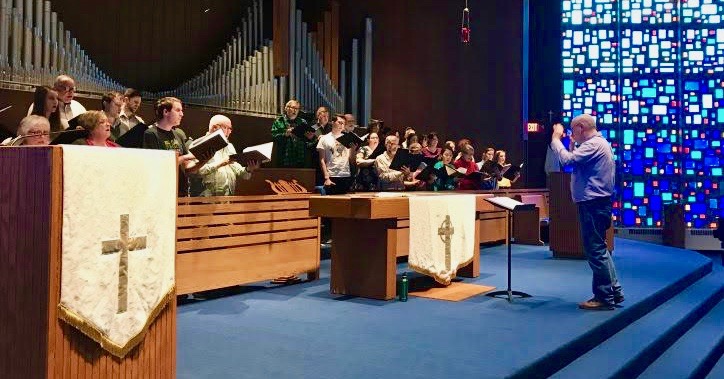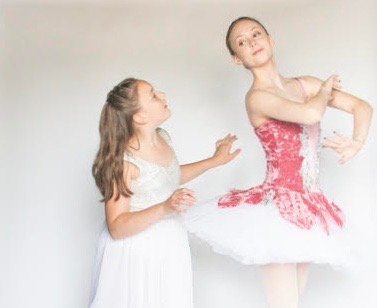By DAVID DUPONT
BG Independent News

Local arts school takes a crack at ‘The Nutcracker’
Sophia Jarrell, founder and director of the Black Swamp Fine Arts School, has danced in“The Nutcracker” first as a tiny dancer, and then with the Ballet Theater of Toledo as a teenager. She’s seen it performed every year sice was 8.
Hayley Havener, the school’s director dance, performed the iconic ballet when she was very small, and then at the end of her own time on stage with a dance company in Akron.
Now almost four years since the founding of the school, which offers dance and music lessons, they are ready to realize their dream of staging their own “Nutcracker.”
The Black Swamp Fine Arts School will stage the iconic holiday ballet on Saturday Dec. 7 at 7 p.m. and Sunday Dec. 8 at 4 p.m. at the Bowling Green Performing Arts Center. Tickets are $15 for general admission and $30 for the VIP experience. (https://www.blackswampfineartsschool.com/nutcracker).
“It’s always been a ballet and a story that a lot of people have treasured,” Jarrell said. “I thought it would be a great experience for our students to perform this and tell this story, especially a full length production.”
The school’s dancers have performed 30-minute shows, but now Jarrell and Havener decided that they had enough students who were “at a level to support the roles, and have the roles danced well,” Jarrell said.
“So we were like ‘let’s give it a shot and dream up our own version of it.’”
Havener said the ballet offers a variety of roles to fit dancers from the smallest to adults, not just in ability but also personality.
Some just want to be the sneaky, mischievous mice, while others want to wear tutus and spin gracefully on stage.
The dancers will perform to a recording of Tchaikovsky’s original symphonic score — using live music would be too difficult at this point, Jarrell said.
“So much of dancing is muscle memory,” Havener said. When learning new choreography it’s important to have consistency, though performing with live music is an option in the future.
Havener and Jarrell have re-written the story to better suit the gender mix and ages of their dancers.
Given the paucity of boys, they’ve opted to give the lead two sisters instead of a mischievous brother, and the prince and the pas de deux have been eliminated.
Taking out that love interest makes it more kid friendly, Havener said. “We changed things around to suit who we had in the studio.”
The Snow Queen gets a more prominent role. They are bringing in Kelly Korfhage from Cleveland’s Verbs Ballet to dance that role and that of the Sugar Plum Fairy.
They’ve set it in the composer’s native Russia in 1816, the year E.T.A. Hoffmann published the original story. That tale has dark elements, so the original choreographer Marius Petipa based the 1892 ballet on Alexandre Dumas’ version of the tale. The story has gone through various permutations since then based on whatever company is staging the ballet.
So for the Black Swamp School’s version the lead becomes Masha, and the godfather figure becomes a merchant rather than a toy maker. He’ll be played by the father of a cast member Mike Ross, who also will employ some of his skills as a magician as part of his act.
The sweets become items from countries that Russia would have traded with in 1816, notably Turkey for coffee and India for spices.
This is all an attempt to add connective threads to hold the story together in a more coherent fashion. Havener said to it can feel disjointed.
The production uses elements of dance from those countries in its choreography, and costuming.
Havener said she’s had a love of historical costuming since high school, also she and a friend handle the design and alterations. Some costumes were imported from India.
Jarrell and Havener at first anticipated that the dancing would be the biggest challenge given many of the dancers are cast in more than one role, and the necessity of additional rehearsal time.
That’s going well, Jarrell said. “They have really met a very high bar.”
It’s the costuming, prop making, and scenery that’s been the challenge with Havener, Jarrell, her husband , Michael, and some volunteers handling those chores. This is the most elaborate show that the school has produced.
All of it though lays the groundwork for future years.
Every day the students want to hear the countdown to showtime. The teachers are less excited about time slipping away.
Not that they aren’t also excited to putting their vision of this dance classic on stage.
“We’re taking a lot of liberties,” Jarrell said. “This is the biggest holiday tradition for any dancer. We’re starting our own tradition.”

‘Ceremony of Carols’ centerpiece of Joyous Sounds
Three years ago, The University Choral Society, conducted by Mark Munson, first presented Joyous Sounds: A Yuletide Celebration.
Now in its third year, it has become something of tradition. The free program will be presented Tuesday, Dec. 3 at 7 p.m. in the First United Methodist Church.
The program features the 60-voice chorus that brings together community members and students, the BGSU Graduate Brass Quintet, and organist Michael Gartz.
Each year the chorus sings one extended work, and that’s surrounded by other sounds of the season. Nothing says Christmas like a choir and brass, said Munson. Add “Silent Night” sung in a candlelit sanctuary, and the concert becomes a fitting way to summon in the Christmas season.
The centerpiece for this year’s Joyous Sounds will be Benjamin Britten’s “Ceremony of Carols” featuring harpist Julie Buzzelli.
The piece was composed by Britten in 1942 for boys choir and harp. It is an evocative sound painting of the nativity story that plays off the fragile nature of a babe born in a stable against the forces of evil that babe will combat. The piece itself is at once delicate and forceful.
The poetry and bits of theology are written largely in Middle English, early Modern English, and Latin.
These archaic syllables play against Britten’s modern musical sensibility where touches of dissonance mix with haunting melodies.
“Ceremony,” Munson noted, is extremely popular. He’s conducted it before with the Women’s Chorus on campus, but this is the first time he’s done a version for the full range of mixed voices.
This year the chorus and the brass will not play together, but the quintet will intersperse music throughout. This gives the quintet a venue for a late semester concert. Gartz will also be featured with a solo.
“We usually have a large audience when we do these things in the community,” Munson said.
The audience will also be invited to add their voices to the celebration on “What Child Is This?” And “O Little Town of Bethlehem.”
The program culminates with “Silent Night” sung by candlelight.
Every year, Munson said, he comes up with a different way of presenting it. Last year because of personnel in the chorus, he had the piece evoke the original setting with acoustic guitar and sung in German.
This year Buzzelli will perform the tune solo before the chorus joins in.
The concert comes as the chorus also prepares for a performance of Carl Orff’s “Carmina Burana” with the Toledo Symphony Orchestra, Feb. 14 and 15 in the Toledo Museum of Art Peristyle. Munson said it was enjoyable for the chorus to be able to alternate rehearsing the two pieces.
They will also perform Haydn’s “Mass in Time of War” with the Bowling Green Philharmonia on May 3.

